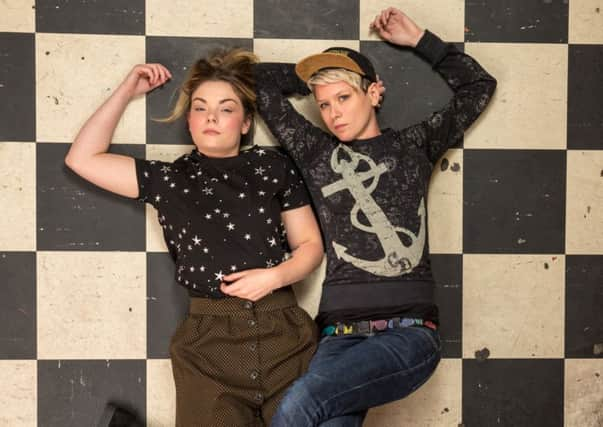Interview: Stina Tweeddale and Cat Myers of Honeyblood


“Yes,” says Tweeddale, without hesitation. “I love being scared and the idea of spookiness, and I like being in a heightened state.”
Tweeddale’s favourite book is Dracula, which perhaps explains her relish when recounting tales from Honeyblood’s sojourn in their isolated old water mill hideaway.
Advertisement
Hide AdAdvertisement
Hide Ad“It looked a bit gothic,” she says. “We set all the gear up in the basement, because that’s clearly what would happen in a horror movie. There was this massive painting on the wall with a dead moose and a wolf ripping its throat and a vulture, and someone had just thrown red paint at it to look like blood. I stared at that constantly for four days and I really think that had an impact on the album.”
Did you split up to search the house?
“Yeah, we did all that. We went outside to a little summerhouse and the door was open and there was an old Victorian dentist chair with a tray of instruments laid out. The next day it was locked and nothing was said about it.”
Having avoided a Marathon Man-style orthodontic confrontation, there was further food for overactive imaginations when their jamming was interrupted by the patter of footsteps coming from the floor above.
“Obviously being attracted to that sort of danger, I ran upstairs and there was a tiny little girl running about in a tutu. You couldn’t make it up. I think it just solidified the fact that it was going to be a creepy album.”
We can neither confirm nor deny that this encounter with the mill owners’ inquisitive daughter had
any bearing on the subsequent
video for the band’s current single Ready For The Magic, in which a
pack of feral young girls stalk the naïve Honeyblood to an incendiary end in the autumnal Scottish countryside.
Advertisement
Hide AdAdvertisement
Hide AdBut all this gleeful indulgence in horror imagery should not imply that Babes Never Die makes for uneasy listening. If anything, it is a pleasure to encounter its righteous rocking down a dark alleyway. It’s an appealing follow-up to Honeyblood’s self-titled debut, which turned heads (in a non-Exorcist fashion) in 2014, and first introduced Tweeddale’s natural knack for a melodic hook.
Tweeddale had previous experience in bands, fronting Edinburgh indie outfit Boycotts, but was looking for an outlet for her own songs when she formed Honeyblood in 2012 and encountered immediate demand for her crafted but kicking indie pop nuggets.
“I am really relentless when it comes to melody – a melody that is simple, effective and singalong and all the words connect together and make a sound that’s effortless, that’s really what I’m going for,” she says.
This time round, Tweeddale has added a conceptual twist, influenced by the character-led storytelling songs of Belle & Sebastian, with whom Honeyblood toured the US last year.
“I spent a lot of time on the first album writing about myself which can get quite boring after a while. I didn’t think anyone would hear those songs as I just wrote them for pals to sing along to. So it was a conscious effort to put that aside for this album.”
Tweeddale’s right-hand woman in her catchy crusade is seasoned drummer Cat Myers, who was drafted into the band in late 2014 following the sudden departure of original drummer Shona McVicar and had to hit the ground running on a succession of tour dates. The pair clicked and Honeyblood Mk.2 was seamlessly birthed.
“We just seeped together,” says Myers. “That’s a weird way to describe it, but we didn’t have much time because I was busy before we went away, so we had one jam and then jumped in.”
Advertisement
Hide AdAdvertisement
Hide Ad“I think we both enjoy making as much noise as we can,” says Tweedale of their creative chemistry. “I think that’s important. I don’t think you can slack when there’s just two of us.”
“Yeah, you really notice if 50 per cent of a band make a mistake,” says Myers. “It’s fun for me. Where in other bands you have to leave some room for other people, it’s the opposite in this band, I can fill up more space.”
Forget the power trio – the power duo has become the popular currency since The White Stripes demonstrated what a thunderous racket you could make with just guitar and drums, inspiring current practitioners such as Deap Vally, Slaves and the chart-topping Royal Blood to go on the pincer attack.
Tweeddale is also keen to keep it tight but mighty. “One of the main things we thought about when we wrote these new songs was how to develop and use what we have in a more constructive way to make it fuller rather than add an extra member. It doesn’t come without difficulty but if you can do it, why not do it?”
There is talk, however, of a mysterious third wheel in the band. “We do have Sebastian now,” admits Myers, before revealing “that’s the name we’ve given to a collection of bass sounds and other samples that I trigger.”
“He’d be so offended to hear that it was you who was doing it all,” laughs Tweeddale.
“I just help him along,” says Myers. “I help him get his voice out there.” Disembodied voices, poltergeist presence…you can run, but you can’t hide from Honeyblood.
Babes Never Die is released by FatCat Records on 4 November. Honeyblood play Saint Luke’s, Glasgow, 8 December.